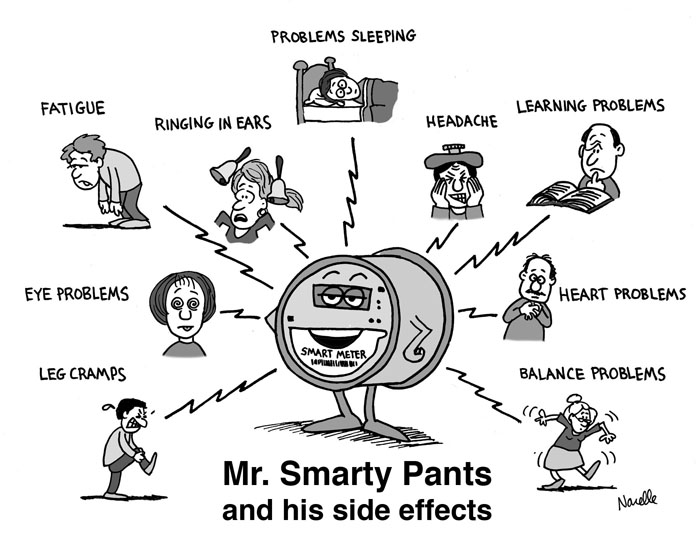 Thanks to Ronald Powell Ph,D for placing two reviews of smart meter health impacts side by side. He compares the EMF Safety Network Survey results (USA 2011 ) to an Australian peer reviewed study by Dr. Frederica Lamech (AUS 2014). The results are astoundingly similar, especially when you account for the different methods for gathering the raw data. Network’s survey was distributed online with boxes of symptoms to check off, and Dr. Lamech’s study tallied written responses.
Thanks to Ronald Powell Ph,D for placing two reviews of smart meter health impacts side by side. He compares the EMF Safety Network Survey results (USA 2011 ) to an Australian peer reviewed study by Dr. Frederica Lamech (AUS 2014). The results are astoundingly similar, especially when you account for the different methods for gathering the raw data. Network’s survey was distributed online with boxes of symptoms to check off, and Dr. Lamech’s study tallied written responses.
Category: Science
How do EMF’s affect us?
According to Dr. Martin Pall, EMF’s affect us through activation of voltage gated calcium channels, not by heating.
Please, watch Dr. Pall talking in Oslo, Norway, on October 18, 2014, about electrosmog as the new health and environmental pollutant.
Dr. Olle Johansson says “This is real science at it’s best!”
Electromagnetic fields act via activation of voltage-gated calcium channels to
produce beneficial or adverse effects Dr. Martin Pall, 2013
Study links cell phones to addiction
 College students spend an average of 8 hours or more a day on their cellphones and women spend the most time, up to ten hours a day. Excessive use poses potential risks for academic performance, according to a Baylor University study on cellphone activity published in the Journal of Behavioral Addictions.
College students spend an average of 8 hours or more a day on their cellphones and women spend the most time, up to ten hours a day. Excessive use poses potential risks for academic performance, according to a Baylor University study on cellphone activity published in the Journal of Behavioral Addictions.
The study notes that approximately 60 percent of college students admit they may be addicted to their cell phone, and some indicated they get agitated when it is not in sight, said Roberts, lead author of the article “The Invisible Addiction: Cellphone Activities and Addiction among Male and Female College Students.”
“That’s astounding,” said researcher James Roberts, Ph.D., Professor of Marketing in Baylor’s School of Business. “As cellphone functions increase, addictions to this seemingly indispensable piece of technology become an increasingly realistic possibility.”
General findings of the study showed that:
• Of the top activities, respondents overall reported spending the most time texting (an average of 94.6 minutes a day), followed by sending emails (48.5 minutes), checking Facebook (38.6 minutes), surfing the Internet (34.4 minutes) and listening to their iPods. (26.9 minutes).
• Men send about the same number of emails but spend less time on each. “That may suggest that they’re sending shorter, more utilitarian messages than their female counterparts,” Roberts said.
• Women spend more time on their cellphones. While that finding runs somewhat contrary to the traditional view that men are more invested in technology, “women may be more inclined to use cellphones for social reasons such as texting or emails to build relationships and have deeper conversations.”
• The men in the study, while more occupied with using their cellphones for utilitarian or entertainment purposes, “are not immune to the allure of social media,” Roberts said. They spent time visiting such social networking sites as Facebook, Instagram and Twitter. Among reasons they used Twitter were to follow sports figures, catch up on the news — “or, as one male student explained it, ‘waste time,’” Roberts said.
Excessive use of cellphones poses a number of possible risks for students, he said.
“Cellphones may wind up being an escape mechanism from their classrooms. For some, cellphones in class may provide a way to cheat,” Roberts said.
Excessive or obsessive cellphone use also can cause conflict inside and outside the classroom: with professors, employers and families. And “some people use a cellphone to dodge an awkward situation. They may pretend to take a call, send a text or check their phones,” Roberts said.
Roberts noted that the current survey is more extensive than previous research in measuring the number and types of cellphone activities. It also is the first to investigate which activities are associated significantly with cellphone addictions and which are not.
Study participants were asked to respond to 11 statements such as “I get agitated when my cellphone is not in sight” and “I find that I am spending more and more time on my cellphone” to measure the intensity of their addiction.
The study noted that modern cellphone use is a paradox in that it can be “both freeing and enslaving at the same time.”
“We need to identify the activities that push cellphone use from being a helpful tool to one that undermines our well-being and that of others,” Roberts said.
Baylor University did a previous where they reported “Cell phone and instant messaging addictions are driven by materialism and impulsiveness and can be compared to consumption pathologies like compulsive buying and credit card misuse, according to a Baylor University study in the Journal of Behavioral Addictions.”
“Cell phones are a part of our consumer culture,” said study author James Roberts, Ph.D., professor of marketing and the Ben H. Williams Professor of Marketing at Baylor’s Hankamer School of Business. “They are not just a consumer tool, but are used as a status symbol. They’re also eroding our personal relationships.”
Cell phones linked to anxiety, lower grades, and unhappiness
 Almost everywhere you look someone has a cell phone pressed to their ear, or has one in their hand. Students depend on the devices to connect with friends and family.
Almost everywhere you look someone has a cell phone pressed to their ear, or has one in their hand. Students depend on the devices to connect with friends and family.
A recent study led by Kent State University researchers, surveyed more than 500 undergraduate students from 82 different majors. They recorded daily cell phone use along with anxiety and happiness levels. In addition student grades were included in the study.
Results were students who used their cell phones more had lower grades, higher anxiety, and less happiness relative to their peers who used the cell phone less.
Earlier this year, Kent researchers linked cell phone use to poor student fitness. These results suggest that people should be encouraged to reduce their cell phone use! Or, better yet, use them for emergencies only!
Safety tips for cell and cordless phone use: Learn more
Dr. Mercola’s comments on this study include raising awareness about second hand radiation effects.
Dr. Mercola writes: “Respect Others Who Are More Sensitive: Some people who have become sensitive can feel the effects of others’ cell phones, iPads, and other gadgets in the same room, even when it is on but not being used. If you are in a meeting, on public transportation, in a courtroom or other public places, such as a doctor’s office, keep your cell phone turned off out of consideration for the “secondhand radiation” effects. Children are also more vulnerable, so please avoid using your cell phone near children.”
Students demonstrate wireless hazards at Science Faire
Two young scientists researched and studied wireless health risks for science fair projects. One student was interested in the controversy surrounding wi-fi and whether it should be in schools or not. She found fruit flies exposed to industrial wi-fi had genome mutations. Another student researched mobile phone radiation and warns about brain cancer, insomnia and other health problems.
In May of 2013 a team of Danish 9th grade girls did a science study on wi-fi and found watercress seeds would not grow near a wi-fi router.
The students placed six trays filled with water cress in a room without radiation, and six trays in another room next to two wi-fi routers. Over the next 12 days, the girls observed, measured, weighed and photographed their results. The cress seeds placed near the routers had not grown, whereas the cress seeds in the other room, away from the routers, thrived.
 The experiment earned the girls top honors in a regional science competition and the interest of scientists around the world. Full story here: Student Science Experiment Finds Plants won’t Grow near Wi-Fi Router
The experiment earned the girls top honors in a regional science competition and the interest of scientists around the world. Full story here: Student Science Experiment Finds Plants won’t Grow near Wi-Fi Router
Physicians group says smart meters effect health: “The evidence is irrefutable.”
 An international organization of physicians and scientists recognize smart meters are harming people’s health. They say, “The evidence is irrefutable.” and call for further research, accommodations and avoidance of smart meters. This new statement is based on a review of cases by Dr. Lamech in Australia. Here’s their recently adopted statement: Smart Meter Case Series
An international organization of physicians and scientists recognize smart meters are harming people’s health. They say, “The evidence is irrefutable.” and call for further research, accommodations and avoidance of smart meters. This new statement is based on a review of cases by Dr. Lamech in Australia. Here’s their recently adopted statement: Smart Meter Case Series
“Founded in 1965 as a non-profit medical association, the American Academy of Environmental Medicine (AAEM) is an international organization of physicians and scientists interested in the complex relationship between the environment and health.
AAEM physicians and physicians world wide are treating patients who report adverse, debilitating health effects following the installation of smart meters, which emit electromagnetic frequencies (EMF) and radiofrequencies (RF).
The peer reviewed, scientific literature demonstrates the correlation between EMF/RF exposure and neurological, cardiac, and pulmonary disease as well as reproductive disorders, immune dysfunction, cancer and other health conditions. The evidence is irrefutable. Despite this research, claims have been made that studies correlating smart meter emissions with adverse health effects do not exist.
The AAEM has received a case series submitted by Dr. Federica Lamech, MBBS, Self- Reporting of Symptom Development from Exposure to Wireless Smart Meters’ Radiofrequency Fields in Victoria. AAEM supports this research. It is a well documented 92 case series that is scientifically valid. It clearly demonstrates adverse health effects in the human population from smart meter emissions.
The symptoms reported in this case series closely correlate not only with the clinical findings of environmental physicians, but also with the scientific literature. Many of the symptoms reported including fatigue, headaches, heart palpitations, dizziness and other symptoms have been shown to be triggered by electromagnetic field exposure under double blind, placebo controlled conditions. Symptoms in this case series also correlate with the Austrian Medical Association’s Guidelines for the Diagnosis and Treatment of EMF Related Health Problems.
It is critically important to note that the data in this case series indicates that the “vast majority of cases” were not electromagnetically hypersensitive until after installation of smart meters. Dr. Lamech concludes that smart meters “may have unique characteristics that lower people’s threshold for symptom development”.
This research is the first of its kind, clearly demonstrating the correlation between smart meters and adverse health effects.
Based on the findings of this case series, AAEM calls for:
- Further research regarding smart meter health effects
- Accommodation for health considerations regarding smart meters.
- Avoidance of smart meter EMF/RF emissions based on health considerations, including the option to maintain analog meters.
- A moratorium on smart meters and implementation of safer technology
- Physicians and health care providers to consider the role of EMF and RF in the disease process, diagnosis and treatment of patients.
Passed by the Board of Directors of the American Academy of Environmental Medicine October 23, 2013
Update:
See also: Dr. Ron Powell’s “Symptoms after Exposure to Smart Meter Radiation”: http://emfsafetynetwork.org/wp-content/uploads/2010/08/Symptoms-after-Exposure-to-Smart-Meter-Radiation.pdf
Kids at risk for cancer on wireless iPads in schools
TV news: World Health Organization says wireless is a cancer risk just like lead, engine exhaust, and chloroform. Newscasters recognize our kids are at risk on wireless iPads in school.
Letter to SUSD
Schools in California and beyond are transitioning away from books to computer based learning. In many cases they’re using wireless computers (iPads) to teach at least two subjects, math and language arts. This is part of a new federal curriculum called Common Core.
In my comments to the Sebastopol Union School District I advocate for an alternative technology plan creating a hardwired computer lab for testing and test preparation. Click here to view the original Letter to SUSD
In Sebastopol the school district is presenting their technology plan on Wednesday September 18 at 4:30 at 7611 Huntley Ave.
9/16/2013 To: Members of the School Board, staff, and teachers Sebastopol Union School District 7611 Huntley Ave. Sebastopol CA. 95472Re: Comments on Common Core Technology Plan
The Sebastopol Union School District (SUSD) board is considering adopting a technology plan that converts students from book based learning to computer based learning and testing. This will be presented on September 18 at the board meeting as agenda item 9.1,1, and possibly be adopted at the next board meeting in October. As a parent of a sixth grader at Brookhaven, and director of the EMF Safety Network, I ask SUSD to apply the precautionary principle and adopt an alternative plan that reduces and limits children’s screen time and wireless exposure.
An alternative plan is to create a hardwired computer lab, for testing and test preparation, instead of using computers in classrooms for lessons and testing. This request is based on health advocacy warnings and recommendations from the World Health Organization, American Academy of Pediatrics, Kaiser Permanente, American Academy of Environmental Medicine and other medical and science experts.
According to a Kaiser Family Foundation survey in 2010, children between the ages of 8-18 spend an average of 7 hours and 38 minutes on technology every day.2
- How many more hours of screen time will children have if schools convert to computer based learning?
- Will children also be expected to do their homework on computers?
- Will the new technology and supporting infrastructure be wired or wireless?
- Are parents adequately informed and included in the decision making process on whether or not to increase their children’s computer use?
Apply the Precautionary Principle to Ensure Safer Learning in Schools
The Precautionary Principle is based on ‘do no harm’ and ‘better safe than sorry’ philosophy. “When an activity raises threats of harm to the environment or human health, precautionary measures should be taken even if some cause and effect relationships are not fully established scientifically. 3
Kaiser Permanente recommends limiting screen time to less than 2 hours a day for teens, less than 1 hour a day for children ages 3 through 12, and no screen time for children under 3. 4 Kaiser explains: “Alot of kids spend more time in front of a screen than they do reading, talking with family and friends, or playing outside. It’s also affecting their health. Too much screen time is associated with: violent behavior, poor school performance, lower reading scores, sleep pattern disturbances, being overweight, consumption of junk food and bad habits later in life (like tobacco and alcohol abuse).”
The American Academy of Pediatrics states,“…studies consistently show that older children and adolescents utilize media at incredibly high rates, which potentially contributes to obesity and other health and developmental risks.”The Academy supports limiting screen time and media use for children and adolescents. 5
Wireless is a Health Risk and a Possible Carcinogen
In May 2011,the World Health Organization classified wireless radiation a possible carcinogen6. This classification is based on studies linking cell phone radiation to brain cancer, but it also applies to all wireless devices, including wi-fi routers and computers.
The American Academy of Environment Medicine (AAEM) in a letter7 to Los Angeles Unified School district (LAUSD) discusses why precaution for wireless is warranted and strongly recommends hardwiring computers in schools. AAEM writes, “There is consistent emerging science that shows people, especially children are affected by the increasing exposure to wireless radiation….Adverse health effects from wireless radio frequency fields, such as learning disabilities, altered immune responses, and headaches, clearly exist and are well documented in the scientific literature”.The AAEM states 3% of children and staff will be immediately affected 30% will have time-delayed reactions.
Apple provides warnings about health risks of iPads8 including headaches, blackouts, seizures, convulsion, eye or muscle twitching, loss of awareness, involuntary movement, or disorientation. There are consumer complaints about iPad health symptoms on the Apple support Forum.9“Is it just me or someone else also feels dizzy or nausea after using iPad for a while?
“YOU ARE NOT ALONE!!! I’ve been getting it too…”
” I have the same problem you have… I looove the ipad but I don’t think I can keep it as I get nausea and feel a bit dizzy just using it for a few minutes.”
“… just today finished series of tests…echocardiogram, brainscan, ultrasound on carotid artery,..the works…to diagnose dizziness, and even one fainting episode..since Xmas. Guess what I got for Christmas…iPad…”
Federal Safety Guidelines Don’t Protect Children
The Federal Communications Commission (FCC) wireless guidelines are for short term (30 minutes) thermal exposures only. There are no safety guidelines specific to children. The FCC is currently reviewing their guidelines, based on a US Government Accountability Office request.10
Dr. Martha Herbert, a Harvard pediatric neurologist and neuroscientist writes,“Children are more vulnerable than adults, and children with chronic illnesses and/or neurodevelopmental disabilities are even more vulnerable… Current technologies were designed and promulgated without taking account of biological impacts other than thermal impacts. We now know that there are a large array of impacts that have nothing to do with the heating of tissue. The claim from wifi proponents that the only concern is thermal impacts is now definitively outdated scientifically.” 11
Dr. Ted Litovitz, physicist, stated many studies are showing biological effects below the FCC thermal limit, including psychological changes, stress response, DNA damage, and affects on the immune system, heart, and blood brain barrier. According to Dr. Litovitz biological effects are seen at 75,000 times below the FCC guideline!12
Create a Hardwired Computer Lab and Limit Screen Time
Faced with new testing standards and a new common core curriculum the schools are caught between new government mandates and health authorities safety recommendations. SUSD should not mandate computer based learning and computers in the classrooms. Instead, use the funding to create a hard wired computer lab, and limit children’s use to testing, and test preparation. Provide waivers for those parents, or students opposed, or medically unable to test on computers.
Some students will not feel well in a computer based environment and this will affect their ability to concentrate and learn. In Canada one family has sued the school district because the wi-fi in school makes both their children sick. With public schools throughout California and beyond transitioning to wireless computer based learning, this problem will only increase. What will SUSD do to keep more vulnerable children safe?
Furthermore, while you have the funding to upgrade technology, its a great opportunity to ensure all internet connections, including teachers and staff computers are hard wired for the safety of students, teachers and staff. Please keep the phone lines within the school wired and corded too!
Please feel free to contact me with your comments and or questions. I regret I will not be able to present this information in person on Wednesday.
Thank you for your consideration,
Sandi Maurer EMF Safety Network PO BOX 1016 Sebastopol, CA 95473“I have no doubt in my mind that at the present time, the greatest polluting element in the earth’s environment is the proliferation of electromagnetic fields. I consider that to be far greater on a global scale than warming, and the increase in chemical elements in the environment.’’- Dr Robert O. Becker, Author of Cross Currents and The Body Electric
Footnotes
1 http://webschoolpro.com/home/CA49709386052211/Agenda%20September%202013/CCSS%20Expenditure%20Plan%2013-14-1.pdf
2Generation M2: Media in the Lives of 8- to 18-Year-Oldshttp://kff.org/other/event/generation-m2-media-in-the-lives-of/
3 Science and Environmental Health Network FAQ http://www.sehn.org/ppfaqs.html
4 Kaiser Permanente: “Limit Screen Time for healthier Kids”
5 AAP letter to the Federal Communications Commission dated July 12, 2012 http://www.scribd.com/doc/104230961/American-Academy-of-Pediatrics-letter-to-the-FCC
6Wireless devices-potential cancer risk says World Health Organization http://emfsafetynetwork.org/?p=4386
7 AAEM letter to LAUSD: http://aaemonline.org/images/LettertoLAUSD.pdf
8 Apple iPad users manual http://manuals.info.apple.com/MANUALS/1000/MA1524/en_US/iPad_Important_Product_Information_Guide.pdf
9 Apple Support Forum https://discussions.apple.com/thread/2399586?start=0&tstart=0
12http://emfsafetynetwork.org/?p=11094
Additional Resources
The BioInitiative 2012 Report is an analysis by 29 independent scientists and health experts from around the world about possible risks from wireless technologies and electromagnetic fields. http://www.bioinitiative.org
Wi-fi in schools video: A ten minute introduction to wireless precaution in schools (Australia) http://youtu.be/GJPTzaNkcUk
Professor Olle Johansson Warns of Wireless DNA Damage to children / two minute video http://emfsafetynetwork.org/?p=9990
Is Wi-fi Safe? http://emfsafetynetwork.org/?p=10576 video
Excerpts from eight expert letters submitted to the LAUSD, by Joel Moskovitz, PhD, Director, Center for Family and Community Health, School of Public Health, UC Berkeley: http://www.saferemr.com/2013_03_01_archive.html
‘Safe Schools 2012′. Medical and Scientific Experts Call for Safe Technologies in Schools. http://wifiinschools.org.uk/resources/safeschools2012.pdf
Scientific Panel on Electromagnetic Field Health Risks: The Selentun Statement
http://www.sagereports.com/smart-meter-rf/docs/Fragopoulou_et_al_2010b.pdf
EMF World Concerns Summary: A compilation of what government, public health and environment organizations and officials, independent scientists, health advocacy groups and activists are advocating around the world in response to the proliferation of EMF, and especially wireless radiation. http://emfsafetynetwork.org/?p=116
Wi-fi in Schools, a consumer advocacy website focused on wi-fi in schools: http://wifiinschools.com/